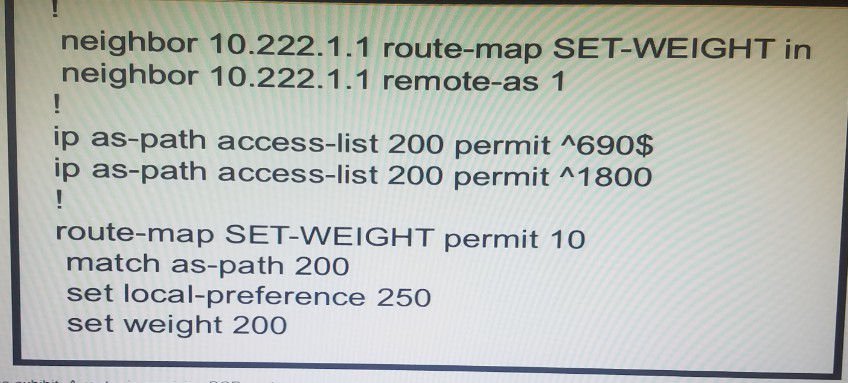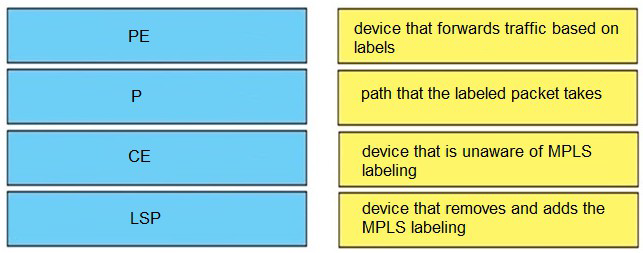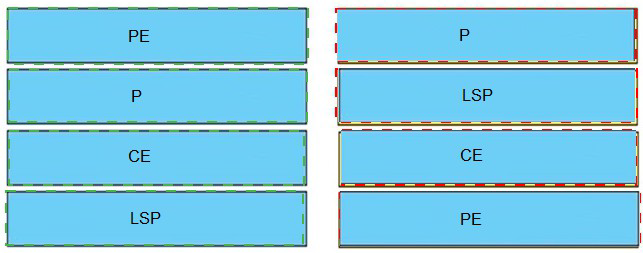Topic 1, Exam Pool A
Refer to the exhibit.

A router receiving BGP routing updates from multiple neighbors for routers in AS 690. What is the reason that the router still sends traffic that is destined to AS 690 to a neighbor other than 10.222.1.1?
A.
The local preference value in another neighbor statement is higher than 250.
B.
The local preference value should be set to the same value as the weight in the route map.
C.
The route map is applied in the wrong direction.
D.
The weight value in another neighbor statement is higher than 200.
The route map is applied in the wrong direction.
Which statement about route distinguishers in an MPLS network is true?
A.
Route distinguishers allow multiple instances of a routing table to coexist within the edge router.
B.
Route distinguishers are used for label bindings.
C.
Route distinguishers make a unique VPNv4 address across the MPLS network.
D.
Route distinguishers define which prefixes are imported and exported on the edge router.
Route distinguishers make a unique VPNv4 address across the MPLS network.
Which two methods use IPsec to provide secure connectivity from the branch office to the headquarters office? (Choose two.)
A.
DMVPN
B.
MPLS VPN
C.
Virtual Tunnel Interface (VTI)
D.
SSL VPN
E.
PPPoE
DMVPN
Virtual Tunnel Interface (VTI)
An engineer configured a leak-map command to summarize EIGRP routes and advertise specifically loopback 0 with an IP of 10.1.1.1.255.255.255.252 along with the summary route. After finishing configuration, the customer complained not receiving summary route with specific loopback address. Which two configurations will fix it? (Choose two.)

A.
Configure access-list 1 permit 10.1.1.0.0.0.0.3.
B.
Configure access-list 1 permit 10.1.1.1.0.0.0.252.
C.
Configure access-list 1 and match under route-map Leak-Route.
D.
Configure route-map Leak-Route permit 10 and match access-list 1.
E.
Configure route-map Leak-Route permit 20.
Configure access-list 1 permit 10.1.1.0.0.0.0.3.
Configure route-map Leak-Route permit 10 and match access-list 1.
Explanation: When you configure an EIGRP summary route, all networks that fall within the range of your summary are suppressed and no longer advertised on the interface. Only the summary route is advertised. But if we want to advertise a network that has been suppressed along with the summary route then we can use leak-map feature. The below commands will fix the configuration in this question:
R1(config)#access-list 1 permit 10.1.1.0 0.0.0.3
R1(config)#route-map Leak-Route permit 10 // this command will also remove the
“route_map
Leak-Route deny 10” command.
R1(config-route-map)#match ip address 1
What is the role of a route distinguisher via a VRF-Lite setup implementation?
A.
It extends the IP address to identify which VFP instance it belongs to.
B.
It manages the import and export of routes between two or more VRF instances
C.
It enables multicast distribution for VRF-Lite setups to enhance EGP routing protocol capabilities
D.
It enables multicast distribution for VRF-Lite setups to enhance IGP routing protocol capabilities
It extends the IP address to identify which VFP instance it belongs to.
Which statement about IPv6 ND inspection is true?
A.
It learns and secures bindings for stateless autoconfiguration addresses in Layer 3 neighbor tables.
B.
It learns and secures bindings for stateless autoconfiguration addresses in Layer 2 neighbor tables
C.
It learns and secures bindings for stateful autoconfiguration addresses in Layer 3 neighbor tables.
D.
It learns and secures bindings for stateful autoconfiguration addresses in Layer 2 neighbor tables.
It learns and secures bindings for stateless autoconfiguration addresses in Layer 2 neighbor tables
Refer to the exhibit.

Network operations cannot read or write any configuration on the device with this configuration from the operations subnet. Which two configurations fix the issue? (Choose two.)
A.
Configure SNMP rw permission in addition to community ciscotest.
B.
Modify access list 1 and allow operations subnet in the access list.
C.
Modify access list 1 and allow SNMP in the access list.
D.
Configure SNMP rw permission in addition to version 1.
E.
Configure SNMP rw permission in addition to community ciscotest 1.
Modify access list 1 and allow operations subnet in the access list.
Configure SNMP rw permission in addition to community ciscotest 1.
Which transport layer protocol is used to form LDP sessions?
A.
UDP
B.
SCTP
C.
TCP
D.
RDP
TCP
Explanation: LDP multicasts hello messages to a well-known UDP port (646) in order to discover neighbors. Once the discovery is accomplished, a TCP connection (port 646) is established and the LDP session begins. LDP keepalives ensure the health of the session.
Thanks to the LDP session, LDP messages create the label mappings required for a FEC. Withdraw messages are used when FECs need to be torn down.
Drag and drop the MPLS terms from the left onto the correct definitions on the right.


Which list defines the contents of an MPLS label?
A.
20-bit label; 3-bit traffic class; 1-bit bottom stack; 8-bit TTL
B.
32-bit label; 3-bit traffic class; 1-bit bottom stack; 8-bit TTL
C.
20-bit label; 3-bit flow label; 1-bit bottom stack; 8-bit hop limit
D.
32-bit label; 3-bit flow label; 1-bit bottom stack; 8-bit hop limit
20-bit label; 3-bit traffic class; 1-bit bottom stack; 8-bit TTL
Explanation: The first 20 bits constitute a label, which can have 2^20 values. Next comes 3 bit value called Traffic Class. It was formerly called as experimental (EXP) field. Now it has been renamed to Traffic Class (TC). This field is used for QoS related functions.
Ingress router can classify the packet according to some criterion and assign a 3 bit value to this filed. If an incoming packet is marked with some IP Precedence or DSCP value and the ingress router may use such a field to assign an FEC to the packet. Next bit is Stack bit which is called bottom-of-stack bit. This field is used when more than one label is assigned to a packet, as in the case of MPLS VPNs or MPLS TE. Next byte is MPLS TTL field which serves the same purpose as that of IP TTL byte in the IP header
Refer to the exhibit.

In which circumstance does the BGP neighbor remain in the idle condition?
A.
if prefixes are not received from the BGP peer
B.
if prefixes reach the maximum limit
C.
if a prefix list is applied on the inbound direction
D.
if prefixes exceed the maximum limit
if prefixes exceed the maximum limit
What is a function of IPv6 ND inspection?
A.
It learns and secures bindings for stateless autoconfiguration addresses in Layer 3 neighbor tables
B.
It learns and secures bindings for stateless autoconfiguration addresses in Layer 2 neighbor tables
C.
It learns and secures bindings for stateful autoconfiguration addresses in Layer 2 neighbor tables.
D.
It learns and secures bindings for stateful autoconfiguration addresses in Layer 3 neighbor tables.
It learns and secures bindings for stateless autoconfiguration addresses in Layer 2 neighbor tables
| Page 7 out of 47 Pages |
| Previous |